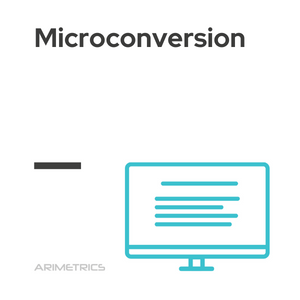
Definition:
A microconversion is each of the actions that the user completes on a web page and that can lead directly or indirectly to the final goal established by the company, also called macroconversion. The ultimate goal can be to buy a product/service, get a lead or download an application.
Micro conversions are very important in a company’s digital marketing strategy because their analysis helps optimize every step of the conversion funnel with the goal of not losing users during the customer day. Knowing what has generated interest in users and improving it is, therefore, essential to increase the conversion rate.
Types of microconversions
There are mainly two types of micro conversions, depending on their influence on the achievement of the final goal:
- Milestones of a macroconversion. They represent the linear process that the user has followed to complete a macro conversion and their importance lies in the fact that they allow to improve the user experience in the different phases until the purchase or acquisition. These milestones can be choosing a product and adding it to the basket, selecting a date at a hotel or choosing a purchase method on the cart page.
- Secondary actions. They encompass the movements that the user makes around the website of a company and that can anticipate future macro conversions. Although they are more indirect actions, they help reinforce the brand image and give some notoriety to the website. Some examples are sharing an article on social networks, subscribing to newsletters, writing a comment about a product or watching a tutorial.
How to measure microconversions
The customer’s path to a conversion can give many clues to know what is happening on a web page, discover optimization opportunities and detect the problems that cause users to get lost. To do this, it is essential to monitor micro conversions through an analytics tool after precisely defining the conversion funnel and each of its phases.
The most used tool is Google Analytics,which allows you to measure a microconversion through:
- Landing page (URL). Knowing through which pages users arrive at a website helps to implement actions to try to lead you towards conversion.
- Duration. It is the average time that the user stays on the web.
- Page views per session. It is related to the above and helps to know if the user does not stay solely on the landing page.
- Events. It can be defined in a personalized way and can be, for example, clicking a purchase button.
With the information collected through Google Analytics, important factors can be determined as:
- The ratio of microconversion to macroconversion.
- The average decision time of the user.
- Which are the channels that generate the most traffic to focus advertising on them and improve their content.
- Which landing pages work best and what improvements could be made to the user experience(UX).
- The type of audience and how to customize actions to direct your customer journey.
For the measurement of microconversions to be effective, it will also be necessary to analyze the market in which the company moves and how the competition works. In the event that a web page does not receive enough traffic to allow reliable metrics to be extracted, the most effective thing is to perform A/B test hypotheses.
